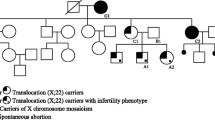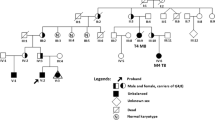Summary
Carriers of the standard translocation t(11;22) (q23.3;q11.2) produce only one type of unbalanced offspring, a tertiary trisomy resulting into the karyotype 47,XX or XY, +der(22)t(11;22)(q23.3;q11.2), usually derived from the mother. The exception is one single patient 47,XY,t(11;22)(q23.3;q11.2),+der(22)t(11;22) (q23.3;q11.2)pat. We report a second case with the same karyotype, also of paternal origin. Thus, the rare unbalanced offspring of a carrier father (only 5 cases known) may receive a supernumerary der(22), as a consequence of tertiary trisomy, but also as a consequence of nondisjunction at meiosis II of a balanced spermatocyte.
Similar content being viewed by others
References
Fraccaro M, Lindsten J, Ford CE, Iselius L, et al. (1980) The 11q;22q translocation: a European collaborative analysis of 43 cases. Hum Genet 56:21–51
Iselius L, Lindsten J, Aurias A, Fraccaro M, et al. (1983) The 11q22q translocation: a collaborative study of 20 new cases and analysis of 110 families. Hum Genet 64:343–355
Laurie DA, Hulten MA (1985a) Further studies on bivalent chiasma frequency in human males with normal karyotypes. Ann Hum Genet 49:189–201
Laurie DA, Hulten MA (1985b) Further studies on chiasma distribution and interference in the human male. Ann Hum Genet 49:203–214
Lockwood DH, Farrier A, Hecht F, Allanson J (1989) Not all chromosome imbalance resulting from the 11q;22q translocation is due to 3∶1 segregation in first meiosis. Hum Genet 83:287–288
McDermid HE, Duncan AMV, Brasch KR, Holden JJA, et al. (1986) Characterization of the supernumerary chromosome in cat eye syndrome. Science 232:646–648
Schinzel A, Schmid W, Fraccaro M, Tiepolo L, et al. (1981) The “cat-eye-syndrome”: dicentric small marker chromosome probably derived from a no. 22 (tetrasomy 22pter-to q11) associated with a characteristic phenotype: report of 11 patients and delineation of the clinical picture. Hum Genet 57:148–158
Author information
Authors and Affiliations
Rights and permissions
About this article
Cite this article
Simi, P., Ceccarelli, M., Barachini, A. et al. The unbalanced offspring of the male carriers of the 11q;22q translocation: nondisjunction at meiosis II in a balanced spermatocyte. Hum Genet 88, 482–483 (1992). https://doi.org/10.1007/BF00215688
Received:
Issue Date:
DOI: https://doi.org/10.1007/BF00215688




